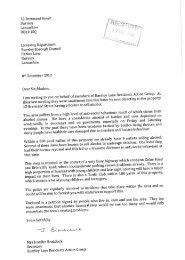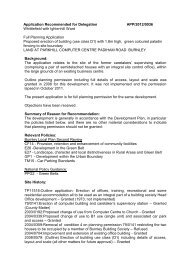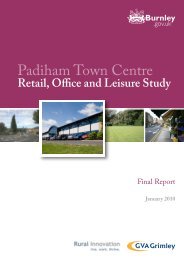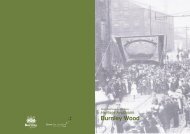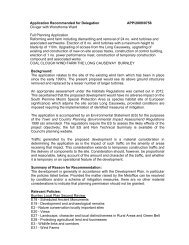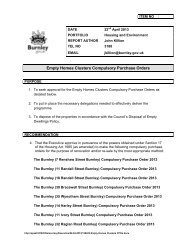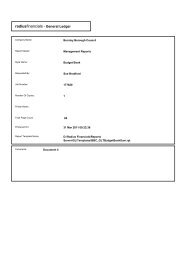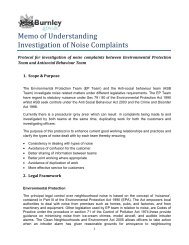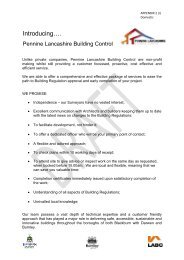The Padiham Heritage Appraisal - Burnley Borough Council
The Padiham Heritage Appraisal - Burnley Borough Council
The Padiham Heritage Appraisal - Burnley Borough Council
- No tags were found...
Create successful ePaper yourself
Turn your PDF publications into a flip-book with our unique Google optimized e-Paper software.
1880s Whittaker Street8.4.9 Development continued westwards in 1881 with terraced residential properties builton the southern part of Park View, then known as Whittaker Street, along with 5 Park Road.Mr J Whittaker who had also built early houses in Railway Road where he himself lived, builtthe earliest of these houses (41-43) on Colonel Starkie’s land in 1881, and gave the street itsoriginal name of Whittaker Street which it held until 1928. 35-39 were developed by AdmiralMoorhouse (see Railway Road above) in 1885.8.4.10 5 Park Road is the only property listed on Park Road in the 1891 census. It was builtby the Duxbury Brothers, one of <strong>Padiham</strong>’s leading stonemasons and building contractors in1886 at the same time as the adjoining commercial property (presumably their yard). 5 ParkRoad subsequently became the family residence of John Duxbury. 13-21 Park View were laterbuilt on the yard which moved across Station Road to Park View works.1890s and later8.4.11 14-22 Station Road were the first properties built on the northern section of StationRoad, adjoining Station Road Bridge. Dating from c.1890, they have slightly narrower-thanusualplan widths with quite large windows and dormers which distinguish these houses fromothers in the area. <strong>The</strong> houses had attics and cellars. <strong>The</strong>y were built by T and J Foster whowere recorded as living at 22 Station Road in 1891 census. Foster and Sons were slaters,plasterers and painters whose offices and workshops were located in the yard at the rear ofthese houses. Stonework is smaller and neater than on adjacent later houses. Number 14, nextto Station Road Bridge, has quoins and was a originally a shop with the door on the oppositeside. 22 with adjacent passage was originally a house. On some early building records this partof Station Road is referred to as Gas Street (BCR 54901). <strong>The</strong> Gas Works were then locatedover Station Road Bridge just outside the character area (Plan B). Fosters built 26-28 in 1906(BCR 54909).8.4.12 24 and 30-32 Station Road were built by W Middlebroughbetween 1892 and 1906. Middlebrough’s wheelwrights was alreadylocated adjacent to Foster and Sons when he added a smithy in1887 which was later moved away from the new houses and closerto the river’s edge. Middlebrough lived at 13 Whittaker Street beforebuilding the house at 24 Station Road as his own residence in 1892(BCR 54901) He developed 30-32 in 1906. Building records for thisperiod also show that Foster, Middlebrough and their neighbour andfellow builder, Duxbury, also collaborated on other developments inthe area (BCR 55208).Gable end of 14 Station Road on the river withformer Park View works in background shortlybefore its demolition8.4.13 <strong>The</strong> early 20th century saw the addition of the northernsection of Whittaker Street (now 1-11 Park View) and the westwardextension of Station Road and Park Road. All these properties wereadded between 1892 and 1910. Differences between the earlier andlater parts of the respective streets in terms of colour, texture andsize of stonework are clearly discernible.Stained glass windows, 30-32 Station Road92 heritage appraisal



